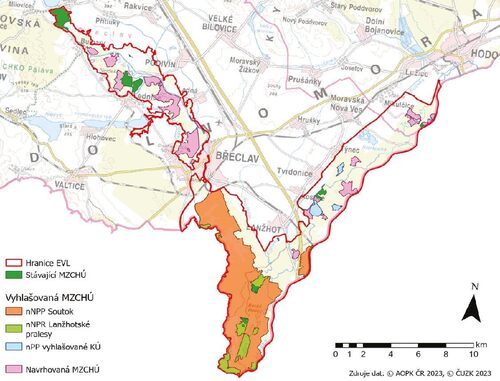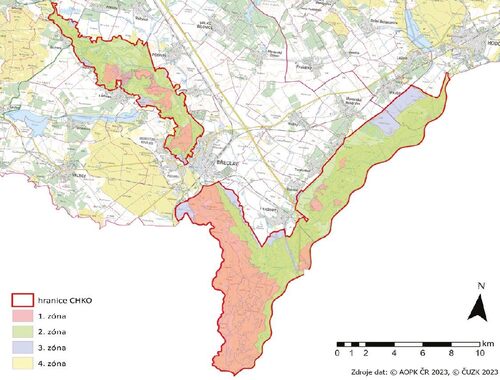Nature Conservation 2024 — 30. 5. 2024 — On Nature in the Czech Republic — Print article in pdf
When Will the Soutok/Morava and Dyje/Thaya Rivers Confluence Protected Landscape Area Be Declared?

In all expert analyses carried out in the last thirty years, the Podluží and the Dyje/Thaya River Floodplain Area below the Nové Mlýny Waterworks (South Moravia) ) was classified as the highest priority for complementing the large-size Specially Protected Area network in the Czech Republic. In addition to including the area into the European Union’s Natura 2000 network, its importance has been confirmed by declaring the Dolní Morava/Lower Morava UNESCO Biosphere Reserve in 2003, thus extending the Pálava/Pavlov Hills UNESCO Biosphere Reserve declared in 1986. Two Ramsar sites/Wetlands of International Importance stretch to the area and its significant parts are also protected by the appropriate cultural heritage legislation. Despite the national and international importance, only 2% of the extraordinarily significant landscape have been included into the Specially Protected Areas.
A unique heritage
Soutok/Morava and Dyje/Thaya Rivers Confluence is located in the lowest part of the Dolnomoravský úval/Lower Moravian Valley; it is a complex of alluvial forests, meadows, and watercourses and water bodies in the floodplains of the Dyje/Thaya River from the Nové Mlýny Waterworks and the Morava River from the town of Hodonín. It is part of the Vienna Basin with a thick sedimentary fill. The majority of the wide Morava and Dyje/Thaya Rivers floodplains is covered by Quaternary sandy-loam sediments, in places discontinuously overlain by windblown sands rising to the surface in the form of so-called “hrúdy”. The entire area is interwoven with a dense network of naturally meandering streams, cut-off meander and permanent and periodically flowing branches, channels and pools. The most important rivers are the Dyje and Morava, and a significant part of the area is drained by the Kyjovka stream. The area is part of the Pannonian Thermophyticum. For the most part, elm-ash forests are represented in the area in a complex with poplar-ash forests, which together form one of the largest hardwood alluvial forest complexes in Europe. In the regularly flooded habitats, especially around the streams, there are fragmentary willow-poplar alluvial forests, and oak-hornbeam on slightly elevated areas. After deforestation, significant areas of the alluvial forest were replaced by botanically valuable alluvial meadows, previously grazed, with iconic solitary centuries-old oaks. Relict xerothermic vegetation is tied to higher unflooded areas and “hrúdy”. Within the Czech Republic, Soutok/Morava and Dyje/Thaya Rivers Confluence represents the most typical example of animal communities tied to all habitats found in the valley floodplains of large rivers. Unique fish communities have developed there and the area is extremely valuable from the point of view of the occurrence of amphibians. Many critically endangered insect and bird species have the most numerous and often the only populations in the Czech Republic.
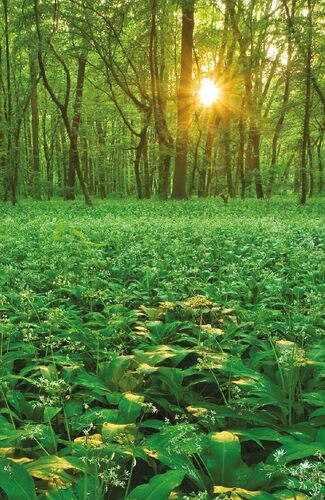
Spring flood of the Wild garlic (Allium ursinum) in a hardwood forest near the town of Břeclav © Jan Miklín
However, Soutok/Morava and Dyje/Thaya Rivers Confluence represents not only a landscape with unique natural values, but also a landscape of extraordinary cultural values, from ancient Slavic settlements (Kuča et al. 2020) to well-known monuments of the picturesque harmonious landscape in the Lednice-Valtice complex.
75 years of conservation efforts
The proposal to protect alluvial forests at the confluence of the Morava and Dyje as “landscape protected areas” had already been included in Šmarda's list of nature reserves in Moravia (Šmarda 1948). In 1949, two small areas were defined in the Podluží area and declared as the so-called “complete reserves”, today the Ranšpurk National Nature Reserve (NNR) and Cahnov-Soutok/Morava and Dyje/Thaya Rivers Confluence NNR, protecting fragments of the ancient old-growth, spontaneously developing alluvial forest.
Efforts to protect the area on a large scale were only revived in the 1970s, before the establishment of the Pálava/Pavlov Hills Protected Landscape Area (PLA) and again in the 1980s in connection with the declaration of the UNESCO Biosphere Reserve there. Changes in society after 1989 brought about the opening of the border zone and, once again, considerations about the form of large-size protection for the complex of alluvial forests and meadows in the area of the Morava and Dyje/Thaya Rivers confluence. Initially, the declaration of a trilateral national park was discussed under the auspices of the World Wide Fund for Nature (WWF International). Finally, in 1992, a draft government regulation was prepared on the protection of part of the Morava and Dyje/Thaya Rivers confluence through the extension of the Pálava/Pavlov Hills PLA, which the Ministry of the Environment of the Czech Republic (MoE) sent for comments to municipalities, owners, and other partners in the affected area (Matuška 1993). This first proposal for protection as a PLA contained the entire Lednice-Valtice complex and only a part of the complex of alluvial forests and floodplain meadows south of the town of Lanžhot (see Fig. 1). Thus, the definition of the PLA came significantly closer to Šmarda's proposal for a “landscape protected area” from 1948. Unfortunately, the regulation was ultimately not submitted to the government by the Ministry (Matuška 2016).
In 1995–1997, an evaluation of the entire PLA network in the Czech Republic took place in terms of representativeness and was the basis for the Strategy for the Development of Protected Landscape Areas (Pelc et al. 1997). The overlap of the PLA with sites of European and supra-regional importance, with biosphere reserves and with Ramsar sites was examined. An important output was the analysis in relation to the delineation of bioregions, phytogeographical and vegetational geographic division. The result was a proposal to supplement the network by approximately two per cent of the area of the Czech Republic. The recommendations were reflected in the State Programme for Nature and Landscape Protection of the Czech Republic (Mlčoch et al. 1998) which, inter alia, included among its priority tasks the declaration of a PLA in the area of the Morava and Dyje confluence. After the approval of the State Programme for Nature and Landscape Protection and the State Environmental Policy of the Czech Republic (1999), the Strategy for the Development of Protected Landscape Areas was updated. The Programme for the Development of Protected Landscape Areas (Pelc et al. 2000) was thus developed, which, in addition to the two above strategic documents, took into account, inter alia, the Regional Development Strategy of the Czech Republic (1999) and, of course, new findings. The protection of Soutok/Morava and Dyje/Thaya Rivers Confluence appeared among the priorities in this programme as well.
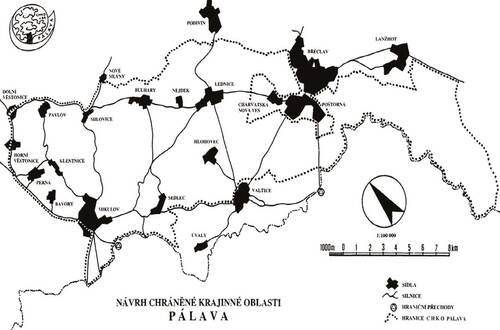
Figure 1 Delineation of the proposed Pálava/Pavlov Hills Protected Landscape Area from 1992, including the Lednice-Valtice complex and part of the floodplain forests south of the town of Lanžhot (Matuška 1993)
In the following period, several partial evaluations of the large-size protected area network s took place in the Czech Republic. In 2003–2004, the “Project of comprehensive evaluation of the existing PLA network and the potential of the Czech landscape from the point of view of possible further territorial development in the Protected Landscape Areas of the Czech Republic” was implemented. The project’s objective was to evaluate the existing PLA network in terms of uniqueness, representativeness, representation of landscape types occurring in the Czech Republic, preservation of the landscape scenery/character, proportion of natural and semi-natural ecosystems, preservation of the natural state of the area, and recreational potential, as well as with regard to the European Ecological Network (EECONET). The second objective was the collection and evaluation of the potential of the Czech Republic's landscape from the point of view of ensuring protection of individual types of landscape units and the elaboration of a proposal for the completion of the PLA network. 23 previously unprotected landscape units in the Czech Republic were defined and their natural and cultural values were assessed (using the same methodology as for PLA evaluation). Only two landscape units of European significance were selected to be added to the PLA system, mainly Dolní Pomoraví/Lower Morava River Basin (Bínová et al. 2004).
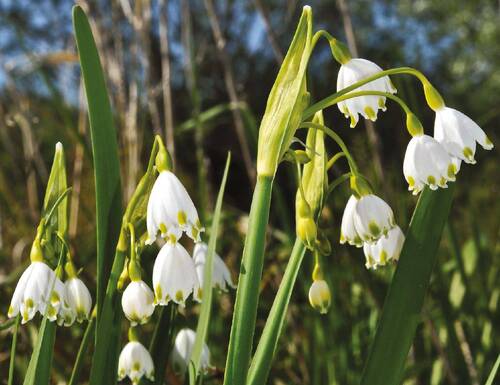
One of the attractive plant species in Soutok/Morava and Dyje/Thaya Rivers Confluence alluvial forests is the Summer snowflake (Leucojum aestivum). © Zdeněk Patzelt
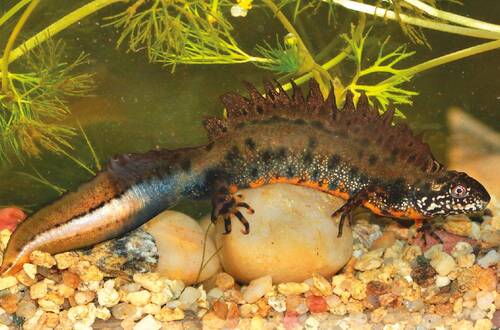
The Danube crested newt (Triturus dobrogicus), found in pools at the confluence of the Morava and Dyje/Thaya Rivers, is one of the rarest and most endangered amphibian species amphibians in the Czech Republic. © Zdeněk Mačát
Second attempt to declare a PLA
A new desire for declaration of a PLA came with joining the EU Natura 2000 network and the declaration of two extensive Sites of European Importance (pursuant to Act No. 114/1992 Gazette on Nature Conservation and Landscape Protection, as amended later, the term for Site of Community Importance, SCI, later Special Areas of Conservation, SAC, under the European Union’s Habitats Directive) (Soutok/Morava and Dyje/Thaya Rivers Confluence-Podluží SAC, 9,713 ha and Niva Dyje/Thaya River Floodplain SAC, 3249 ha) and Bird Areas (pursuant to the above act, the term for Special Protection Area, SPA under the EU Birds Directive) in 2005. Government Regulation No. 132/2005 Gazette assumed that a PLA would be declared in the future to ensure the protection of both SACs. In 2008, on the basis of the assignment of the MoE, Nature Conservation Agency of the Czech Republic prepared the document “Priorities for the declaration of large-size Specially Protected Areas in general and in relation to the Natura 2000 network in the czech Republic”, which developed proposals for the declaration of several new PLAs. Dolní Morava/Lower Morava River was included among the three areas with the highest degree of urgency for declaration, with high natural and landscape value, where Natura 2000 sites (SCIs and SACs) cover 60–90% of their area; incidentally, for the first time with the name Soutok/Morava and Dyje/Thaya Rivers Confluence PLA (Pešout 2010). Subsequently, the NCA CR prepared a complete document for the declaration of a new PLA (including a proposed management plan) including a network of small-size Specially Protected Areas (Slavík et al. 2009a, 2009b).
However, a negative campaign was conducted in the region by some entities opposed to the PLA, based on misleading and even erroneous information about the impact of the PLA on the lives of residents and the region’s prosperity. The consequence of the campaign was the halting of the PLA preparation even before the start of the actual declaration process.
Searching for conservation alternatives
It was necessary to find other ways to ensure the protection of the extremely valuable area of Soutok/Morava and Dyje/Thaya Rivers Confluence. First of all, the possibility of using contractual protection under Article 39 of the Act on Nature Conservation n and Landscape Protection was analysed. This way proved impassable for several reasons. Above all, it is not realistic when dealing with a large number of landowners (contracting parties); even though most of Soutok/Morava and Dyje/Thaya Rivers Confluence is the property of the Czech Republic, many plots there have been still private. Another reason was the need in the contract (or in its appendices) to provide a detailed description of all protective conditions, management principles, and necessary measures to ensure the subjects of protection for an indefinite period of time. It really was an impossible task. Moreover, any change compared to the contract would require a demanding process of changing it, concluding amendments, etc. The unfeasibility of contractual protection was also confirmed during consultation with the South Moravian Regional Office of the South Moravian Region, which would be the competent authority for nature conservation to conclude it.
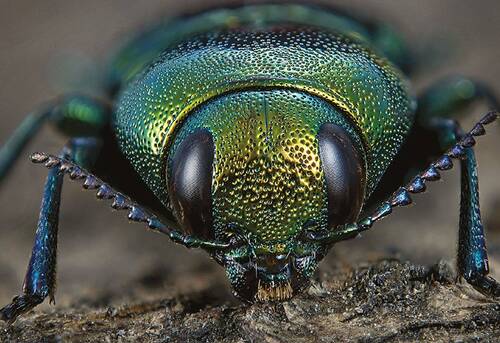
The Oak jewel beetle (Eurythyrea quercus) is one of the rarest insects in the Soutok/Morava and Dyje/Thaya Rivers Confluence area. © Jiří Klváček
The last alternative for the protection, conservation and management of the area thus became an extensive network of small-size Specially Protected Areas. Therefore, in Government Regulation (No. 318/2013 Gazette), the form of protection of the local Natura 2000 sites was changed to “partial protection in the form of NNR (National Nature Reserve), NNM (National Natural Monument), NR (Nature Reserve), and NM (Nature Monument)” and, in 2012, the MoE authorised the NCA CR with drafting the proposal (see Fig. 2), which was discussed in subsequent years with the Regional Office of the South Moravian Region and partners in the region. The NCA CR subsequently developed plans for the declarations and proposals for management plans for Lanžhotské pralesy/Lanžhot Primary Forests NNR and Soutok/Morava and Dyje/Thaya Rivers Confluence NNM. Both Specially Protected Areas were designed to cover the most valuable areas of protected phenomena in this alluvial area and so that they complemented each other from the point of view of ensuring appropriate management. In October 2019, the Ministry announced the plan to declare the NNR and then in March 2020 the plan to announce the NNM (see box). At the beginning of 2023, the discussion of the plans was completed. As part of the declaration process, the MoE dealt with the settlement of objections from several affected entities, while the latest decision on their settlement entered into force on 10th March. Currently, the MoE decrees on the establishment of both Specially Protected Areas are being prepared, which also include the precise definition of the coordinates delineating the border points that are currently being surveyed. In addition, the South Moravian Region is preparing to declare Saufang (21.3 ha), Týnecké fleky (24.7 ha), and Kostická čista (64.8 ha) Nature Monuments. However, the small-size Specially Protected Areas network, although relatively extensive, is not an optimal solution for the protection of such a large area in comparison to the PLA. A significant part of Natura 2000 sites would remain only in the so-called “basic protection” and the area’s professional administration would not be comprehensive due to the division between several State Nature Conservancy authorities.
| The Lanžhotské pralesy/Lanžhot Primary Forests National Nature Reserve (NNR) was proposed in eight separate parts, covering an area of 430 ha. The NNR’s regime was determined primarily to be non-intervention (it is a forest where natural processes occur or have started); the area also includes the existing Ranšpurk and Cahnov-Soutok/Morava and Dyje/Thaya Rivers Confluence NNRs, which have been left to spontaneous development for a long time, but only covering an area of 35 ha. The subjects of protection in the proposed NNR are alluvial forest and oak-hornbeam ecosystems, watercourses and water bodies, tall sedge growths, and flooded meadows. The long-term goal there will be to preserve the habitat of the Pannonian hardwood and softwood alluvial forests and the Pannonian oak-hornbeam and leave them to natural development, as well as the preservation of the accompanying communities of continental inundated meadows, tall sedge vegetation, macrophyte vegetation of watercourses and water bodies, and the creation of suitable conditions for the reproduction of animal species bound to these ecosystems – the sites are also important as nesting grounds for raptors and other bird species in the Soutok/Morava and Dyje/Thaya Rivers Confluence-Tvrdonicko Bird Area (pursuant to Act No. 114/1992 Gazette on Nature Conservation and Landscape Protection, as amended later, the term for Special Protection Area, SPA under the EU Birds Directive). Soutok/Morava and Dyje/Thaya Rivers Confluence National Nature Monument (NNM)/, which surrounds the Lanžhotské pralesy/Lanžhot Primary Forests NNR, was proposed on an area of 3,156 ha. Targeted forest management is planned in the area, taking into account the demands of Specially Protected Species. The restoration of forest stands should thus be spread over several decades and extensive clearings should not be created. Older dense stands should be thinned and old massive trees should be opened to improve light conditions for critically endangered species bound to these habitats. Forest, water, and non-forest ecosystems are the subject of protection there; among the species there are e.g. the Great capricorn beetle (Cerambyx cerdo), European stag beetle (Lucanus cervus), Oak jewel beetle (Eurythyrea quercus), Weatherfish (Misgurnus fossilis), Fire-bellied toad (Bombina bombina), and the Summer snowflake (Leucojum aestivum). The long-term objective of protection is to ensure the existence of hardwood and softwood alluvial forests in lowland rivers and Pannonian oak-hornbeam forests with such a species, age, and spatial structure that will provide conditions for the existence of species bound to open stands. In these stands, but also in meadows, conditions must be ensured for species preferring tree cavities, dying trees and stumps. Another goal should be to preserve meadow communities, ensure the existence of important nesting sites for rare or Specially Protected birds, and also ensure water regime that would correspond to regular natural floods that occurred there in the past. |
Figure 2: Proposed small-size Specially Protected Areas in the Niva Dyje/Thaya River Floodplain and the Soutok/Morava and Dyje/Thaya Rivers Confluence-Podluží Sites of European Importance (pursuant to Act No. 114/1992 Gazette on Nature Conservation and Landscape Protection, as amended later, the term for Site of Community Importance, SCI, later Special Areas of Conservation, SAC, under the European Union’s Habitats Directive)
Figure 3: Delineation of the Soutok/Morava and Dyje/Thaya Rivers Confluence Protected Landscape Area and zoning according to the 2022 proposal elaborated by the Nature Conservation Agency of the Czech Republic
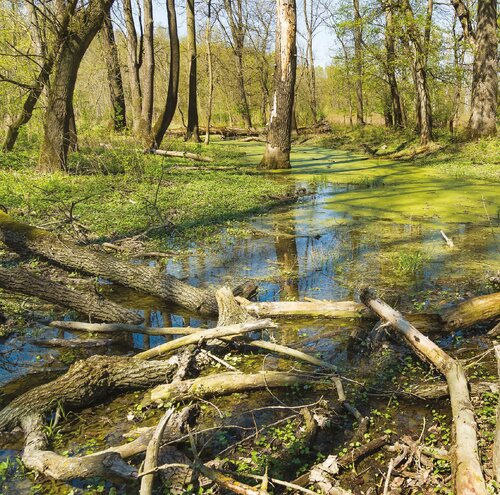
Alluvial hardwood forest in Sekulská Morava River Meander © Jan Miklín
Third time lucky (?)
The Czech Government Programme Declaration from January 2022 contains the plan to ensure the protection of Soutok/Morava and Dyje/Thaya Rivers Confluence by declaring it a National Park. After evaluating possible protection, conservation and management options and considering the threat of deterioration of the subjects of protection in both Natura 2000 sites in the Soutok/Morava and Dyje/Thaya Rivers Confluence area, the MoE decided in June 2022 that it would be most appropriate to seek the declaration of a PLA again and ordered the NCA CR to prepare a new document for PLA establishment.
The new proposal for delineation of the Soutok/Morava and Dyje/Thaya Rivers Confluence PLA was prepared by the NCA CR in such a way as to respect the earlier comments of municipalities and other partners in the region as much as possible (see Fig. 3). The proposed PLA, with a total area of about 12,470 ha, primarily includes both Sites of European Importance (Niva Dyje/Thaya River Floodplain and Soutok/Morava and Dyje/Thaya Rivers Confluence-Podluží, see above) with a smaller reduction by areas built up or otherwise exploited in the interim (reserved for the town of Břeclav road bypass, small areas near municipalities of Bulhary, Lednice, etc.). There are no private houses in the proposed area. Management should be graded according to zones, with Zone I and II being proposed almost exclusively only on forest land, floodplain meadows, and natural water bodies.
In March 2023, the MoE authorized the NCA CR to pre-negotiate the PLA proposal, including delineation, zoning, and more detailed protection conditions. Negotiations are currently underway with municipalities, important owners and managers, associations, relevant state/governmental institutions, and other partners in the area. The goal is to finalize the proposal before handing it over to the MoE, which plans to start the PLA declaration process in 2023, as well as to collect documents for the management plan; establishing a suitable relationship between the economic use of the area and the protection of natural and cultural heritage in cooperation with municipalities and managers is the biggest challenge and task of the prepared PLA. A favourable fact is the prevailing state ownership of the area, and therefore a greater possibility of ensuring professional forestry management of stands that preserves and develops the natural values of the area and restores the water regime needed to preserve the alluvial forest ecosystem. The Podluží and the Lednice-Valtice complex are heavily used by tourists; guiding visitors and agreeing on rules for the further development of environmentally friendly tourism and recreation is the second no less important point for discussion with all partners in the region.
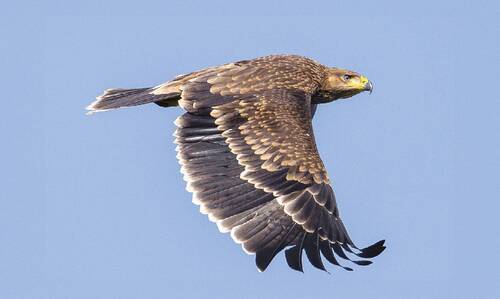
The Imperial eagle (Aquila heliaca) has been nesting at Soutok/Morava and Dyje/Thaya Rivers Confluence since 1998. Currently, up to 6 pairs are nesting in the territory of the proposed Protected Landscape Area. © Vladimir Gahura
From the many negotiations to date, it is clear that everyone involved is concerned with preserving Soutok/Morava and Dyje/Thaya Rivers Confluence as a landscape with an extraordinary concentration of natural and cultural heritage features for future generations. Although the echoes of the negative campaign of PLA opponents from 2008 through irrational worries have sometimes still been visible, most of the comments during the plan’s pre-negotiation are based on real facts and have led to constructive debates about the exact wording of the more detailed protection, conservation and management conditions, delineations, etc. The fundamental improvement in the local attitude towards the plan to declare the PLA Soutok/Morava and Dyje/Thaya Rivers Confluence is due not only to the NCA CR providing sufficient and real information (especially via soutok.nature.cz website), but also to the activities of the professional public and local associations, thanks to which the public can see the need to protect the valuable area the most. Visiting existing PLAs (organized for their citizens by some affected municipalities and the South Moravian Region) have led to a realistic view of the influence of the PLA on life in the municipalities. Let us hope that protection of this unique area will be achieved third time around. ■
- - - -
The list of references is attached to the online version of the article at www.casopis.ochranaprirody cz
- - - -
Cover photo:
Sunrise at Černé louky/Black meadows © Jan Miklín


